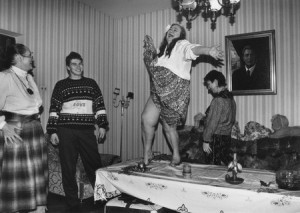The Paris Review's Blog, page 883
October 9, 2012
Cossacks and Clowns and Bears, Oh My!
Galina Brezhnev.
One cold March day in St. Petersburg, I paid a visit to Vladimir Ignatievich Deriabkin, whose apartment does double duty as the Museum of Gramophones. Above me was a gramophone wearing red and white clown shoes, perched on a unicycle. A samovar walked a tightrope across the room, holding a stick to help it keep its balance. Train tracks stretched across the ceiling. Brightly painted, blooming wide, the gramophones were like a garden of enormous morning glories.
I was in St. Petersburg, the city once called the “Russian mirage,” doing research on criminal songs of the Soviet period. My investigations had already taken me to such exotic places as the St. Petersburg Record Collector’s Club, a set of subterranean rooms full of grizzled, toothless men in caps and striped sailor shirts. Escorted into the back room, where the head honchos were celebrating International Women’s Day by drinking cognac from metal jiggers, I suspected that I was the first woman ever to enter the building. One man asked me to marry him, saying that he didn’t want to live in New York but wanted to live as if he were in New York. This intriguing rhetorical turn was the central finding of that day’s research; the men were too busy celebrating to answer my questions.
A helpful friend had told me that Vladimir Ignatievich was someone I absolutely had to meet before I left town, and I hoped that my interview with him would be more fruitful than my trip to the record club. Armed with my dictaphone, notebook, and tattered map, wearing my too-thin, too-short New York coat and my cracked, leaking New York boots, I tramped through the drifts of snow. (The St. Petersburg city administration is lax in clearing the streets—but they do better than Kiev, whose mayor was said to have proclaimed, “Let whoever put the snow down clean it up!”) The Museum of Gramophones was clearly marked and above ground, just off a major thoroughfare, and from the moment I entered it was clear that there was no risk, as with some of my previous research subjects, that I would be invited to consume multiple liters of vodka in the course of my interview.
October 8, 2012
Politics, Nerds, Gunpowder
Cormac McCarthy’s notes reveal a recipe for gunpowder and a very different Blood Meridian.
Goodreads compares the reading habits of Romney and Obama supporters.
J. K. Rowling returns to children’s fiction.
“Using adverbs is a mortal sin,” and other rules for writing fiction from prominent writers.
Ten essential reads for books nerds.
Introducing the Paris Review App!
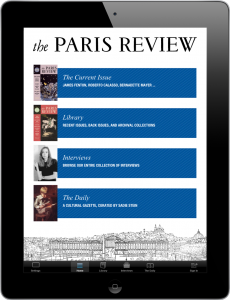 As reported in The New York Times, we’re thrilled to announce the launch of our iPad/iPhone app! On it you’ll find new issues, rare back issues, and archival collections—along with our complete interview series and the Paris Review Daily. And if you download the app by October 21, you’ll receive the current issue, along with an archival issue—Spring 1958, featuring an interview with Ernest Hemingway, early fiction by Philip Roth, and a portfolio by Alberto Giacometti—for free!
As reported in The New York Times, we’re thrilled to announce the launch of our iPad/iPhone app! On it you’ll find new issues, rare back issues, and archival collections—along with our complete interview series and the Paris Review Daily. And if you download the app by October 21, you’ll receive the current issue, along with an archival issue—Spring 1958, featuring an interview with Ernest Hemingway, early fiction by Philip Roth, and a portfolio by Alberto Giacometti—for free!
To current print subscribers: stay tuned! Soon you’ll be granted digital access to any issue covered by your print subscription. Look for an e-mail from us in the next week or two with details on how to set up your account.
And to those with Android devices: we hope to have a version for you soon!
October 5, 2012
Etgar Keret, Tel Aviv, Israel
A series on what writers from around the world see from their windows.
The nicest place I ever got to write in was in MacDowell. My studio there was surrounded by a beautiful snowy forest, and looking out of the windows I could often see deer. During my residency there a friend came to visit. After having a beer together he said, “There is so much beauty around you, yet I can see from the angle at which your computer is placed that when you write all you can see is the toilet. Why is that?”
The answer was simple. When I write, what I see around me is the landscape of my story. I only get to enjoy the real one when I'm done. In the Keret family tradition my writing space is always one of the least desirable spots in our apartment, a place which only a person who is busy writing can bear. Currently it is a small metal table placed between the living room and the kitchen. The moment I stop writing I can notice on the other side of the road a beautiful grand tree allegedly planted sixty years ago by one of Israel’s finest children poets as well as the happy mess my son and I left on the balcony the day before, but this is just for a moment, most of the time I just see my stories which are usually much messier than the balcony floor. —Etgar Keret
But What Is He Reading?
October 4, 2012
Meeting Joan Didion
 Each Sunday, we would walk down Lexington together, the conversation taking the tempo of our steps: slow, meditative, purposeful. She’d always be in immediate need of a coffee, so we would head for our café. The one on Seventy-something, a fifteen-minute walk from her apartment. We would never spend too much time in her apartment beforehand. I would go up to get her, maybe sit in her kitchen for five minutes while she got her things together, keys jangling, and we’d leave. I would try to take in the walls of books, visually inhaling the pillows collected over years and continents, and those curtains—thick buttery beige, like icing. Framed photographs from the seventies—the nuclear family—lining the bookcases, soaked in that sunny filter of the era, then sun-soaked again by the morning light.
Each Sunday, we would walk down Lexington together, the conversation taking the tempo of our steps: slow, meditative, purposeful. She’d always be in immediate need of a coffee, so we would head for our café. The one on Seventy-something, a fifteen-minute walk from her apartment. We would never spend too much time in her apartment beforehand. I would go up to get her, maybe sit in her kitchen for five minutes while she got her things together, keys jangling, and we’d leave. I would try to take in the walls of books, visually inhaling the pillows collected over years and continents, and those curtains—thick buttery beige, like icing. Framed photographs from the seventies—the nuclear family—lining the bookcases, soaked in that sunny filter of the era, then sun-soaked again by the morning light.
At the café, we’d speak of her writing, about what she was working on, what movies we’d each recently seen and if they were any good. If we’d spotted any celebrities downtown, we would share what they’d been wearing and she would tell me her dreams. We would sometimes order two scoops of vanilla ice cream to share, and she’d urge me to finish the last bite. If conversation lagged, I might tell her I felt a West Coast phase coming on.
She would read my writing and tell me what was good and what wasn’t (she’d never say anything like she “saw great potential” in me—nothing like that, nothing that might threaten eyes to roll). She’d advise me as a professional equal and as a child, which is exactly how I would feel sitting across from her, two times her size and one-third her age, her books overstuffing my backpack.
“You don’t think in terms of suddenly making it,” she would tell me, remembering when Play It as It Lays first came out. “You think you have some stable talent that will show no matter what you’re writing, and if it doesn’t seem to be getting across to the audience once, you can’t imagine that moment when it suddenly will.” I would nod. “Gradually,” she’d add, “gradually you gain that confidence.”
She wouldn’t always be nice to me. She might be in a foul mood and take it out on me a bit, but then she would always be fair. That’s how I’d know she was taking me seriously. I would be aware then, I wouldn’t have to wait until I was older to recognize, that this acknowledgment, this leveling, was more valuable than anything else.
Her secrets would be my secrets, and mine hers—in so much as people share their secrets. Keepers of private notebooks are a different breed altogether, she’d say knowingly, eyeing the stacks of journals overflowing my lap, lonely and resistant rearrangers of things, anxious malcontents, children afflicted apparently at birth with some presentiment of loss. I would shrug and scribble a note or two.
I’d learn her way of being, how she took up space. How she liked her eggs, where she’d sniff after words and what that meant, which was her favorite linen dress. And I’d learn to sketch maps of her intellectual processes. I suppose she would learn mine as well. She had many friends, of course, so it wouldn’t be like I was giving her something to do. She would meet with me for some other reason, one that would never be entirely clear to me. Years later, I would still wonder.
The Flanders Duck
Perhaps you’ve seen it: that building out on Route 24, in Flanders, Long Island, that looks like a duck. Thirty feet long and twenty feet tall, it weighs a little over eight tons. It is called the Big Duck, and its white cement body sits in a permanent squat. At the center of its breast is a door that opens into a one-room museum and gift shop. There, three or four days a week, throughout most of the year, Barbara Bixby sits alertly behind the counter. Babs, as she prefers to be called, is a trim sixty-six-year-old with long auburn hair and bangs that fall over her eyes. Her accent is difficult to place. Not Long Island. Not New England. She draws out her words like an old film actress and speaks with great enthusiasm. She is infectiously friendly.
On a Saturday last winter, I trekked out to Flanders to spend an afternoon in the Duck with Babs. I traveled by train and by taxi, and when I arrived just past one P.M., Babs was entertaining a large, dark haired man and his young daughter. The shop smelled of potpourri. The Little Rascals played in black and white on a television set built into the wall. Babs wore a rose-colored sweater (a little threadbare at one elbow), a floral scarf, and a ring on nearly every finger. After the man and girl had gone, she turned to me and said, “What a sweet little lady!”
Babs is one of two duck sitters, and though she insists there is no hierarchy, she is more or less the head duck lady. Read More »
Poetic Prescriptions, Banished Words
Get a prescription form from the Poetry Pharmacy.
A poem written by Sylvia Plath as a college student has surfaced.
This year’s “List of Words Banished from the Queen’s English for Misuse, Overuse, and General Uselessness.”
Orson Welles and Hemingway had a relationship. It was “very strange.”
Mark Twain: “Apparently, the Concord library has condemned Huck as ‘trash and only suitable for the slums.’ This will sell us another twenty-five thousand copies for sure!” Writers respond to having books banned.
October 3, 2012
Dead Authors at Fashion Week: Part 5
Gertrude Stein takes notes from the front row at the Céline Spring 2013 collection.
SILK TWIST.
Look 6.
The change in that is that thick night satin for day. The change has come. There is no sleeve. But there is, there is the understanding of a sleeve. Surely any is unwelcome for spring, but sometime there is breath and there will be trousers that breathe and the pool sandal is charming very charming is that wrapped in and cleansing. Certainly all black for spring is handsome and convincing.

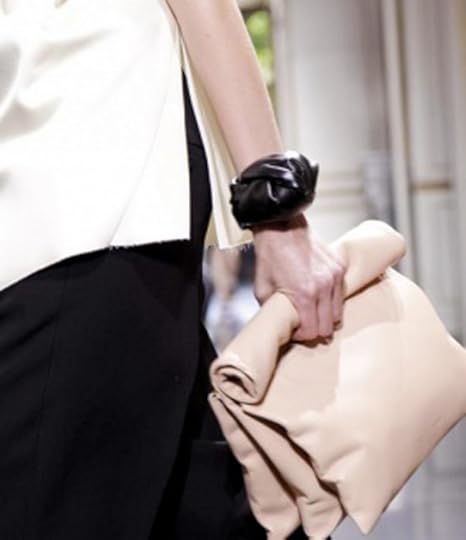
A PURSE.
Look 11.
A purse was not blue, it was not straw color. If it was paper it would be nothing and nothing would be in it but PB and J. It was a leather lunch bag and it showed that it rolled open, that is all that it showed.

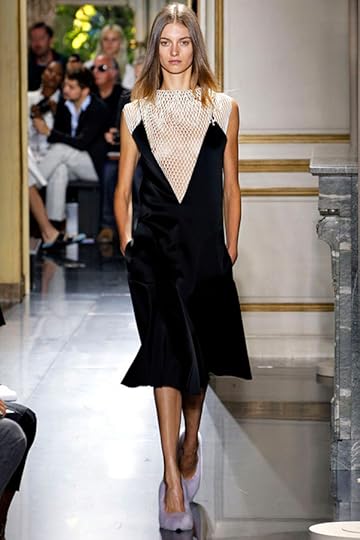
A LITTLE BIT OF A SLIPPER.
Look 13.
A shining indication of strong collections consists in there having been more of the textures that don't belong and bringing in a sense an association like walking on smoke puffs. This was the hope which made the six and seven editors around me feel no use for silly rabbit heels we all pray shed into nothing. Shed into nothing.

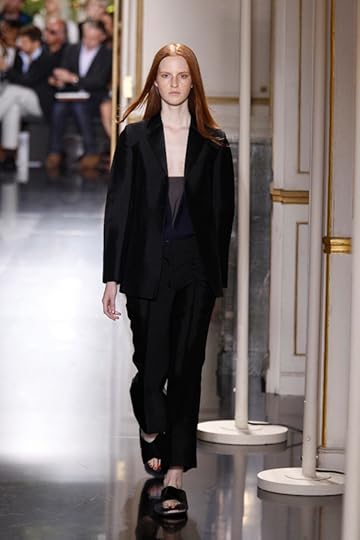
A FUR SHOE.
Look 19.
An elegant use of a house coat and grace and a little piece of a priest collar.
So fur shoes of several kinds imagined in March slush and trailing dust in the salon makes the fluff tufts a joke and really several. Fluff in the slush pile and then on the sandwiches in the lunch bags what I mean is they could be tasty out of context and editorially strong.


MORE.
Look 25.
Yellow fur yellow rather—
No. Ew come on.


NOTHING ELEGANT.
Look 26.
A charm a single fuzz charm is doubtful. If the fashion holds and there is a bad accessory surrounding it, if inside there is a chance for shoes to change and a cool loafer change then certainly something is upright.
Letter from a Haunted House: Part 1
 I rented my apartment, a large studio on the top floor of a three-story house listed in the National Registry of Historic Places, sight unseen, through Craigslist. When my mom asked me, months later, for its address, I had to do a Google search. Among the results was a mention of my place being haunted. I didn’t click on the link. I did mention it to my husband, Clancy, in passing.
I rented my apartment, a large studio on the top floor of a three-story house listed in the National Registry of Historic Places, sight unseen, through Craigslist. When my mom asked me, months later, for its address, I had to do a Google search. Among the results was a mention of my place being haunted. I didn’t click on the link. I did mention it to my husband, Clancy, in passing.
On the day I moved in, without giving it any thought, we started to refer to one storage space—there are three, two low-ceilinged ones on either side of the pitch-roofed room and one closet—as “the bad area.” We had barely walked in, we (at least I) had forgotten the ghost, and here we were—“the bad area.”
In fairness to the rational-minded, the bad area was just that. It had a white door on hinges that came to my chest. The floorboards were unfinished. Brown insulation fiber had come loose in the ceilings and was all over the floor. It was dusty and full of cobwebs. An industrial, kevlar-and-aluminum fire-escape ladder was in one corner. The previous tenant lived here three years. I don't think he swept in there one time. I don't think anyone did. (The other storage area was half open, clean, with finished floors.)Read More »
The Paris Review's Blog
- The Paris Review's profile
- 305 followers


